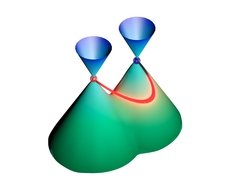Pressemeldung: Discovery of an exotic fundamental particle could speed up your smart phone
A long-sought fundamental particle, the so called Weyl fermion, which was first introduced in high energy physics, has now been discovered in the material called tantalum arsenide (TaAs) as emergent quasiparticles by an international collaboration of scientists.
The German mathematician and physicist Hermann Weyl proposed Weyl fermions nearly one century ago from purely mathematical considerations. Later, some very interesting particles in the universe, including the famous neutrinos, have been speculated as candidates of Weyl fermions, but never confirmed.
Recently, scientists studied electrons in tantalum arsenide and proved that they meet all the criteria of a Weyl fermion, which was predicted in theory early this year. “It is a surprise and excitement that such fundamental particle is first found neither in particle accelerators nor cosmic-ray detectors, but in solid compounds”, said Prof. Yulin Chen from Oxford University, UK and the leader of the research project, “and we can have zillions of them within a small piece of crystal.”
It is even surprising that these fundamental particles, which are usually mentioned in high-energy physics and cosmology, might generate great impact in tiny electronic devices: Weyl fermions do not have any mass like the photons of light and travel super fast in the material. Therefore, a working device with Weyl fermions will generate almost no heat, overcoming the fundament problem of energy dissipation in present day semiconductor devices. Thus, Weyl fermions are ideal candidates for high-speed and energy-efficient electronic devices, which for example could make future generations of electronics faster and more powerful.
Moreover, these fast moving electrons could carry extra information: Weyl fermions have certain “handedness”, meaning the electron spins are either to the right hand or the left hand of the movement direction. These properties also allow the fabrication of new spintronic devices, the next generation of electronics.
“The work by Yulin Chen and his colleagues represents an important advance in the rapidly evolving field of Weyl semimetals in condensed-matter physics. ” said Prof. Stuart S. P. Parkin, the millennium technology prize laureate (2014) from IBM Almaden Research Center (US) when he heard the exciting news. “They clearly discover the existence of Weyl fermions in the compound TaAs but similar features have been observed in NbAs, NbP and TaP by Chen’s group and by two other groups in Princeton and Beijing, almost contemporaneously. The properties of these compounds allow for the easy formation of spin-polarized electron states with well defined momenta by optical or electronic excitations and promise novel electronic, spintronic, valleytronic and opto-electronic technological applications.”
The international collaboration of scientists published their result in Nature Physics [1] on Aug. 17th. The collaborators come from Oxford University, UK, Max Planck Institute for Chemical Physics of Solids in Dresden, Germany, Tsinghua Univesity, China and ShanghaiTech University, China. Experiments were carried out at Diamond Light Source (UK) and Advanced Light Source (USA), where these unique electrons are directly captured by a technique called angle-resolved photoemission spectroscopy (ARPES).
BY, ZH, HR

Observed Weyl fermions and Fermi arcs in TaAs. Red and blue points represent Weyl points with opposite chirality, which are connected by a Fermi arc.











